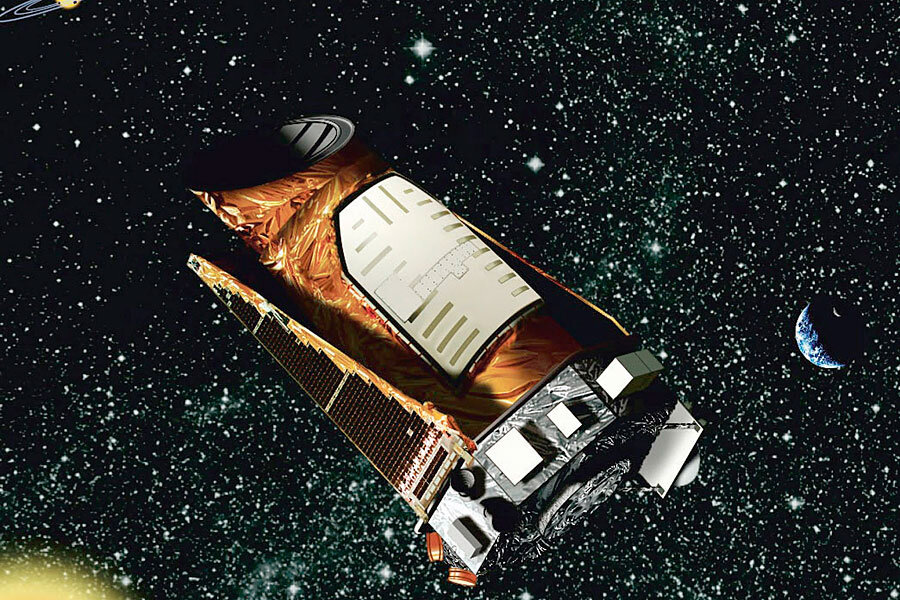Kepler observatory: It still has plenty of planet-hunting left, NASA decrees
Loading...
NASA has approved a new to-do list for its highly successful Kepler orbiting observatory, a planet-hunter extraordinaire whose extended mission was cut short last year by problems with its pointing system.
The craft required exquisite pointing precision in order to look for Earth-mass planets orbiting at Earth-like distances around sun-like stars. The failure of two of four reaction wheels inside the craft compromised that precision.
But clever use of pressure from sunlight hitting the observatory, combined with the two working wheels, have allowed engineers to keep Kepler in the planet-hunting game. And it now has a broader mandate: to provide a treasure-trove of data on a range of other astrophysical phenomenon.
Scientists proposed Kepler's new agenda to NASA last November. The agency sent it out for review, along with proposals involving other missions, to an outside panel of astrophysicists. Their verdict on the value of a new Kepler mission was released Friday – a ringing endorsement of the so-called K2 (Second Light) mission.
"This is an outstanding mission and we look forward to the results from the program. K2 uniquely addresses a range of observational goals and is expected to engage a broad community of scientists," the panel wrote.
For scientists directly involved in the mission, it's been a long wait, but "we're all very happy," says Steve Howell, project scientist for the new mission. Dr. Howell works at NASA's Ames Research Center at Moffett Field, Calif.
Launched in 2009, Kepler began an extended mission in November 2012 with only three of its four reaction wheels working. The use of at least three wheels for pointing was critical for stabilizing the craft so it could detect the faint dip in starlight that takes place when an Earth-mass planet planet travels across the face of its host star.
In May 2013, however, a second reaction wheel failed. Three months and many attempts later to get at least one wheel working again, NASA threw in the towel and announced that the craft's planet-hunting days were over.
Yet its other systems continued to perform well, and the craft had plenty of fuel left to help it maintain its orbit. The agency send out a call to the space-science community for ideas about research tasks that the otherwise healthy spacecraft could still perform.
Last fall, the craft's engineering team improved the craft's chances for a new mission when they devised a way to use the pressure of sunlight to help restore some of the stability the craft had lost.
Among the new agenda's highlights:
• Continue to hunt for planets, especially around the brightest stars in any part of the sky the observatory will be able to view. Kepler will be staring at a portion of the sky for only about 80 days before it slews to the next patch of sky, so it's most likely to detect planets with fairly short orbital periods, Howell explains. Still, because the planets are transiting bright stars, any planets Kepler detects will be ripe for additional observations to help determine the planets' bulk compositions and atmospheric compositions.
• Stare at bright star clusters such as the Pleiades or the Beehive Cluster. The observatory's ability to detect tiny changes in the intensity of light already has provided a wealth of information astrophysicists can use to test their models of how sun-like stars work. These clusters contain stars of all ages and sizes, allowing researchers to extend those insights to more stars covering a wider range of stages in stellar evolution.
• Track the rise and fall of light from exploding stars in other galaxies for clues about the nature and number of stars involved. Too often, astronomers catch such supernovae well after they explode, when that information has long been lost. During its initial mission, Kepler caught three and tracked them from the start, suggesting that it's likely to catch many more during a period in its new mission where it would be looking out into deep space through a region of the Milky Way relatively free of stars. This portal would make it easier for Kepler to monitor hundreds to thousands of other galaxies for supernovae.
The mission currently has fuel for about 2-1/2 years, Howell says. But engineers are exploring ways to use the remaining reaction wheels to substantially reduce the fuel demand. If successful, Kepler 2 could run for four years, he says, NASA willing.






